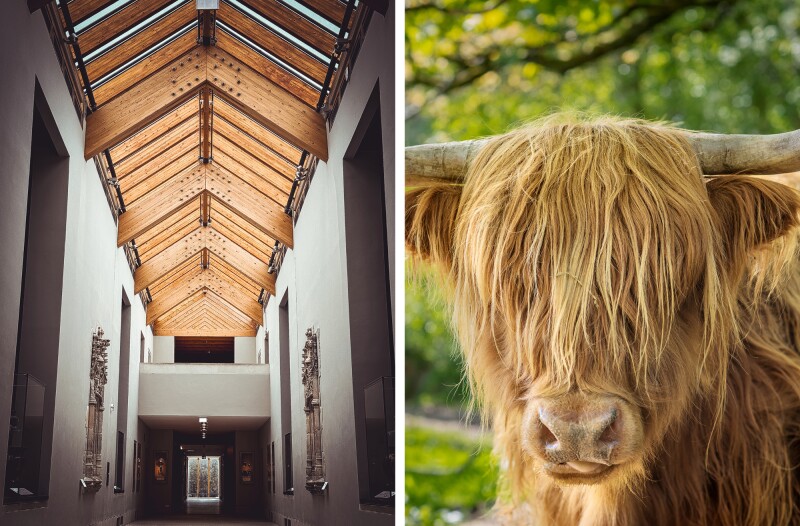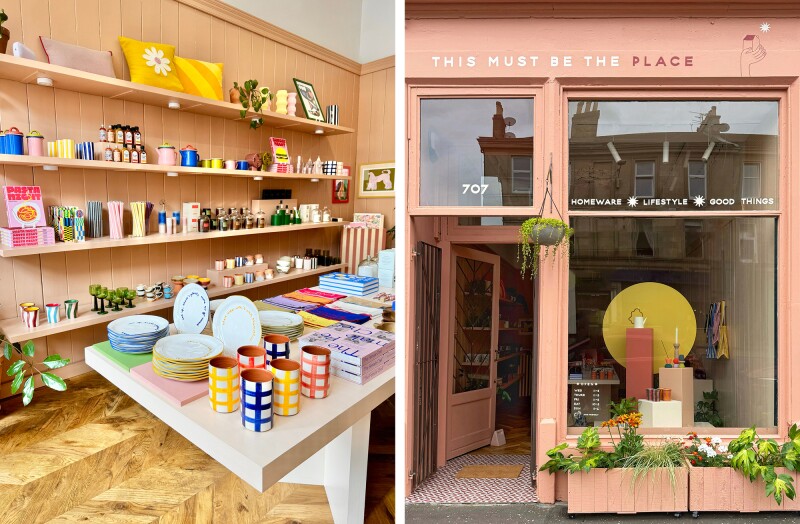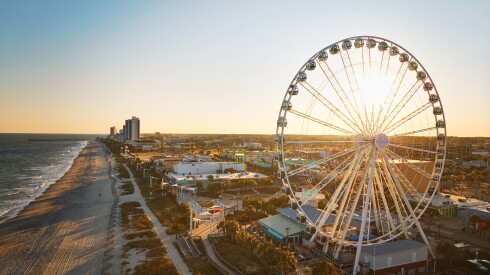Despite being Scotland’s largest city, Glasgow is often overlooked as visitors set their sights on its posh, regal sister, Edinburgh. In recent years, in fact, the castle-on-a-hill capital city has seen about triple the inbound visitors to Glasgow, which has ranked sixth among the most-visited U.K. cities, after London, Edinburgh, Manchester, Birmingham, and Liverpool. Travelers who skip scrappy, artsy Glasgow should give it a second look. The city’s reputation for postindustrial grittiness is largely outdated, and it’s filled with sprawling green spaces, cutting-edge museums, and a restaurant and bar scene that punches well above its weight class—without the crowds who often clog Edinburgh’s stateliest sites.
Now is an especially lovely time to check Glasgow out: 2025 marks the city’s 850th anniversary, which is being celebrated across town with concerts, screenings, food festivals, and a touring pop-up exhibit from the temporarily closed People’s Palace. Beyond the festivities, the best thing about the city is the Glaswegians themselves, who are known for their outsize charm and chattiness. Glasgow has often been voted the friendliest city in the world, so much so that in 2013, it adopted the official tourism slogan “People Make Glasgow.” Here are seven reasons to add this underrated city to your next U.K. itinerary.
You can go on an architectural pilgrimage

House for an Art Lover is one of the best places in the city to immerse yourself in the unique architecture of Charles Rennie Mackintosh.
Photo by Derek D. Galon/Shutterstock
Barcelona has Antoni Gaudí. Chicago has Frank Lloyd Wright. And Glasgow is synonymous with the works of architect, artist, and designer Charles Rennie Mackintosh (1868–1928), whose unique vision modernized Scottish baronial style with art nouveau flourishes and Japanese minimalism. There are plenty of places around the city to experience his work, including Mackintosh Queen’s Cross, the only church designed by him to be built; Mackintosh at the Willow, tearooms that opened in 1903 and now host exhibitions and, of course, afternoon tea; and the less-expected Stereo, a queer café, bar, and music venue housed in the Mackintosh-designed Daily Record building. You can also join a two-hour walking tour that takes in some of his creations and important sites from his life, offered every Saturday at 10 a.m.
But to truly immerse yourself in his world, you’ll want to visit two buildings that didn’t exist during the architect’s lifetime. The Hunterian Art Gallery, on the University of Glasgow campus, hosts the Mackintosh House, the painstakingly re-created interiors of the house he shared with his wife from 1906 to 1914; the original residence was demolished in the 1960s, but furnishings and fixtures were rescued and reassembled so you can see his design vision come to life. On the other side of the River Clyde, House for an Art Lover is hidden away in Bellahouston Park. The space was completed in 1996 from original Mackintosh drawings that date to 1901, and the house now hosts outdoor art installations and a welcoming café.
The city has birthed a renowned music scene
In 2008, Glasgow was named a UNESCO City of Music, the first in the United Kingdom. It’s home to the Scottish Opera, the Royal Scottish National Orchestra, and the Scottish Ensemble. On the rockier side, the city has birthed such bands as Simple Minds, Primal Scream, Belle & Sebastian, Franz Ferdinand, and Travis. If you’re hoping to catch a concert while in town, check out what’s on at King Tut’s Wah Wah Hut, where Oasis was discovered and signed by record execs in 1993, or the Barrowland Ballroom, which celebrated its 90th birthday in 2024 and is beloved for its billboard-sized, animated neon sign.
The museums are world-class—and most of them are free
Glasgow is a city made for museum-hopping: The vast majority of its cultural institutions are free to enter. The city’s crown jewel is the Kelvingrove Art Gallery and Museum, which is home to ancient Egyptian relics, “Sir Roger,” the taxidermied elephant, a Spitfire plane, and Salvador Dalí’s mesmerizing Christ of St. John of the Cross. To get even more bang for your buck, arrive during the daily organ recital, which is performed in the grand entrance hall at 1 p.m. Monday through Saturday and 3 p.m. on Sunday.
Other standouts include Riverside Museum, the city’s transport collection, which is housed in an avant-garde pavilion designed by Zaha Hadid, with a tourable tall ship moored outside; the Gallery of Modern Art, which occupies a neoclassical landmark in the heart of the city; and the Hunterian, a collection of small museums and galleries on the University of Glasgow campus. But you should also venture off the beaten path for more niche collections dedicated to women’s history, the Glasgow police, and religious life and art.
One of the city’s coolest museums shares a park with shaggy Highland cows

The architecture of the Burrell Collection is designed to let in natural sunlight and views of Pollok Country Park (left); the park is also home to a small herd of shaggy Highland cows (right).
Photo by Lassie With a Lens/Shutterstock (Left); yvonnestewarthenderson/Shutterstock (Right)
The Burrell Collection (also free to enter) came into existence in 1944 when Sir William Burrell and his wife, Lady Constance, donated their collection of 9,000 artworks and objects to the city of Glasgow—everything from Egyptian pottery and Ming Dynasty vases to medieval tapestries and stained glass and works by Cézanne and Degas. The collection is impressive, sure, but you’ll be even more wowed by the immersive curation, which includes interactive digital displays for kids and compelling videos that put artworks into historic context: Figures on an ancient Greek vase, for instance, might come to life to tell the story of Hercules, while a clip narrated in British Sign Language explores nonverbal communication in Chinese sculpture.
Even more immersive, however, is the way that many of the gallery windows face out onto the surrounding Pollok Country Park, making the experience of perusing art feel like a stroll through the outdoors. Glasgow’s largest park is home to walled gardens, play areas, an orienteering course, riverside paths, and a small herd of fluffy Highland cattle. Pro tip: Come between March and June, and you’re likely to see newborn calves frollicking in the field.
The restaurant scene is booming

Ox and Finch is one of many Glasgow restaurants showcasing local Scottish ingredients in inventive ways.
Courtesy of Ox & Finch
Glasgow is home to its fair share of chip shops and pubs, but it’s also an incubator for young chefs pushing culinary boundaries. If you don’t know where to start, Finnieston and its surrounding streets offer a particularly dense concentration of restaurants by the Kelvingrove museum: Crabshakk (super-fresh Scottish seafood), Mother India’s Cafe (part of an iconic family of restaurants that’s been going strong for 35 years), Ox and Finch (which serves small plates like ox tongue Welsh rarebit and crispy monkfish cheeks), and Gloriosa (a bright, stylish Italian spot for aperitivos out in the sun).
But no matter where you are around the city, you’ll find a memorable meal. Kicking off a day of exploring the East End? Grab coffee and a pastry at the artsy Outlier, which is planning to open an on-site gallery soon. Just finished touring the Gothic Glasgow Cathedral and the adjacent cemetery, the Necropolis? Duck into Celentano’s, a self-described “restaurant with rooms,” for seasonal pastas and Negronis with house-made vermouth. Looking for a long, leisurely dinner after a day in Glasgow Botanic Gardens? Go for the six-course chef’s menu at Brett, which features dishes such as BBQ lamb breast, mushroom XO linguini, and quail two ways—including a “KFQ leg” (that’s Kentucky-fried quail).
The city’s Southside is filled with warm, walkable neighborhoods

You could spend an entire day browsing the colorful storefronts, like This Must Be the Place, in Glasgow’s creative Southside.
Courtesy of This Must Be the Place
Many of the city’s cultural institutions are found north of the River Clyde, but save a day to wander through the more residential, on-the-rise Southside. Especially charming is the oddly named Strathbungo (the word probably derives from the Scottish Gaelic term for “river valley” plus a derivation of the name of the city’s patron saint, Mungo). Start your day at Sunny Acre, a cheerful café and bakery serving dishes like strawberry tarts and mackerel Nicoise, before hitting up indie shops like the secondhand record store Otherside; the quirky homeware boutique This Must Be the Place, which sells Portuguese pottery, pollinator seed sets, and decorative ceramic borlotti beans (because why not?); and the “fiercely independent and queer” Category Is Books, which hosts events like a queer South Asian book club and a trans history night.
For lunch, try Lobo, a Mediterranean-tinged small-plates place with killer wines starting under $9 a glass; if the hash brown–style patatas bravas are on the menu, order them. Around the corner, Lunar Wine & Cocktail Bar is the place to go for innovative drinks that change with the seasons, and the pink-fronted La Gelatessa Gelato & Coffee often serves Scottish-accented flavors like buttered hot cross buns and chocolate hazelnut with whiskey ganache.
Spend your evening one neighborhood over in Govanhill, on Victoria Road, a five-minute stroll from Strathbungo. Café Buena Vida, inspired by Spanish bodegas, hosts progressive, inclusive radio shows from the bay window out front (order the olives and the vermouth). Finish the night with dinner at Big Counter, a brash, rowdy neo-bistro serving dishes like tartare and frites or obscenely buttery grilled mussels.
The city is a great hub for day trips
Scotland is the size of South Carolina, so you’re never too far from anywhere in the country, but Glasgow is particularly well-suited as a hub for day-trip exploration. The city is less than an hour by train from three locations: the seaside resort town of Ayr, where you can ride Clydesdales on the beach and visit the Robert Burns Birthplace Museum; the historic Stirling, which is home to the National Wallace Monument and the imposing castle where Mary Queen of Scots lived as a child; and Loch Lomond, for paddling, cycling, walking, and wildlife-watching.











